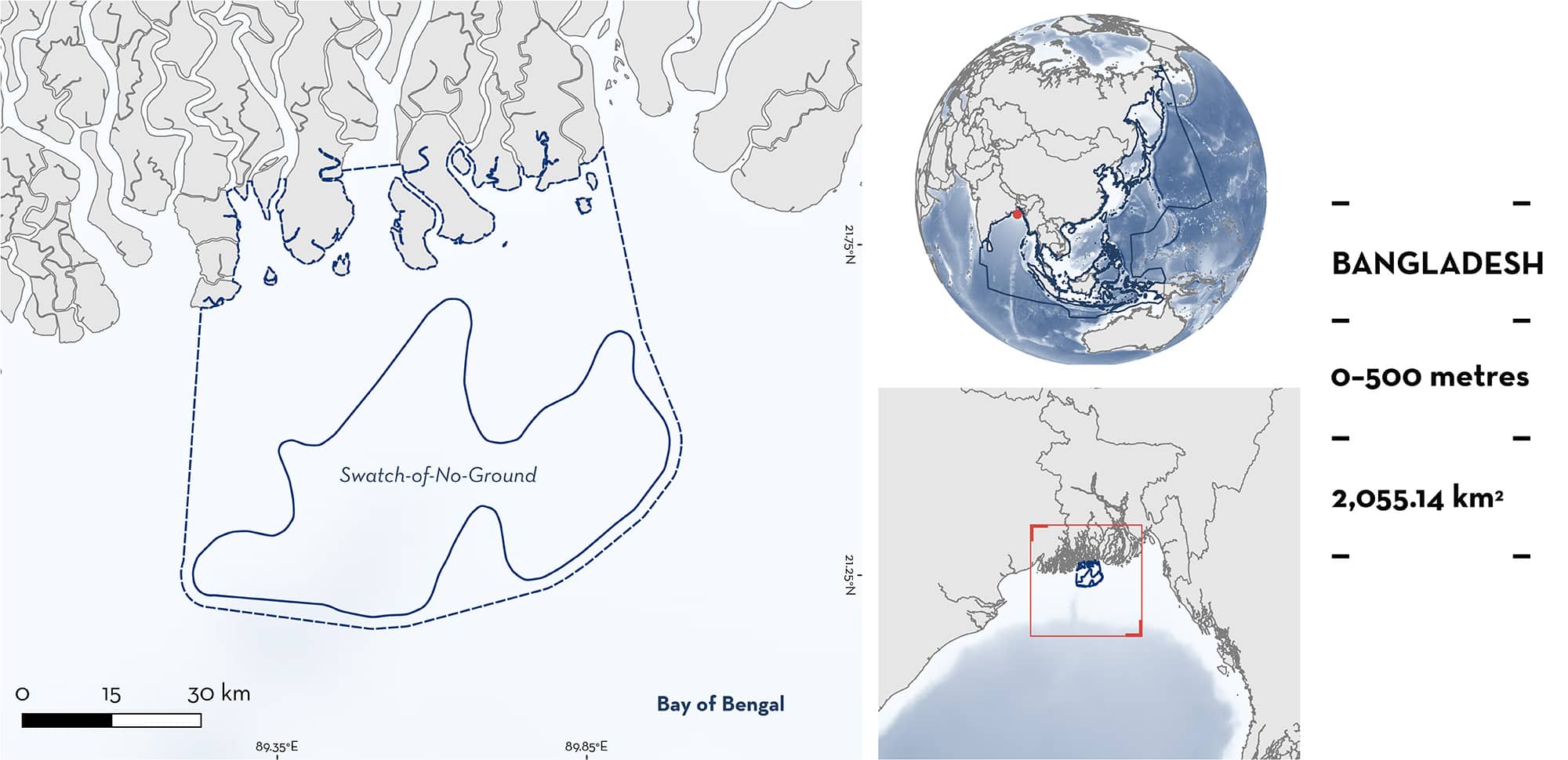ISRA FACTSHEETS
ISRA FACTSHEETS
ASIA REGION
Swatch-of-No-Ground
Summary
Swatch-of-No-Ground is within Bangladesh waters in the northern coastal Bay of Bengal. It sits just offshore of the world’s largest mangrove forest, the Sundarbans, and encompasses the tip of a deep submarine canyon. The area is characterised by muddy waters and substrates forming shifting mudflats, channels, and the world’s largest submarine fan. The area overlaps with the Swatch-of-No-Ground Marine Protected Area. Within the area there are: threatened species (e.g., Bull Shark Carcharhinus leucas); and reproductive areas (e.g., Blacktip Shark Carcharhinus limbatus).
Download factsheet
Swatch-of-No-Ground
DESCRIPTION OF HABITAT
Swatch-of-No-Ground is located on the continental shelf of the northern Bay of Bengal which includes the head of the trough-shaped Swatch-of-No-Ground canyon and surrounding waters south of the Sundarbans mangrove forest (the world’s largest mangrove forest). This submarine canyon crosses the continental shelf diagonally. The water within the area is mostly turbid with muddy substrates (Kudrass et. al 1998; Smith et al. 2008; Subrahmanyam et al. 2008). These features form shifting mudflats, channels, and the world’s largest submarine fan.
During the boreal summer monsoon, the area receives heavy rainfall, while the winter monsoon is dry and cool. Water temperatures vary, with the highest temperatures in the southwest during the summer months, and the coolest temperatures in the northeast during the winter (Kuehl et al. 1997). Salinity also varies between seasons based on inflow from large rivers, with high salinity in the west and comparatively lower salinity in the east (Smith et al. 2008). The monsoon-driven discharge from the large river system mixes with cool, upwelling canyon waters offshore the Sundarbans and is distributed across the epipelagic and mesopelagic zones of the coastal belt by a seasonally reversing tide (Kuehl et al. 1997; Smith et al. 2008).
The area overlaps with the Swatch-of-No-Ground Marine Protected Area.
This Important Shark and Ray Area is benthopelagic and is delineated from surface waters (0 m) to 500 m based on the bathymetry of the area.
CRITERION A
VULNERABILITY
Three Qualifying Species considered threatened with extinction according to the IUCN Red List of Threatened Species regularly occur in the area. These are the Critically Endangered Scalloped Hammerhead (Rigby et al. 2019) and the Vulnerable Blacktip Shark (Rigby et al. 2021a) and Bull Shark (Rigby et al. 2021b).
CRITERION C
SUB-CRITERION C1 – REPRODUCTIVE AREAS
Swatch-of-No-Ground is an important reproductive area for three shark species.
Geo-referenced catch records from 7,238 net sets were collected from 2015 to 2023 via a network of small-scale coastal and marine fishers to understand the spatial ecology and catch characteristics of sharks and rays (BFD & WCS 2021; WCS unpubl. data 2023). Monitored fishers mostly use gill nets targeting Hilsa Shad Tenualosa ilisha or other economically valuable bony fishes, which can result in the incidental capture of sharks. Exact capture locations of the Qualifying Species were provided by the GPS units given to fishers. Length measurements of monitored sharks were compared to published data on size-at-birth (Ebert et al. 2021) to confirm the presence of neonates of these species. Some of the smaller individuals which were well below published size-at-birth likely represent aborted pups. The proportion of neonates represented in the catch suggests that this productive area is a nursery area for these species.
Out of 198 Bull Sharks recorded in the fisheries catch, 144 neonates (73% of the catch) were identified with a size range of 33–69 cm total length (TL) compared to the published size-at-birth of 56–81 cm TL (Ebert et al. 2021). Neonate Bull Sharks were most frequently caught in June, although they were recorded in other months (March, July, September, November).
Out of 688 Blacktip Sharks, 491 neonates (71% of the catch) were identified with a size range of 23–71 cm TL compared to the published size-at-birth of 38–72 cm TL (Ebert et al. 2021). Neonate Blacktip Sharks were most frequently recorded in October and November, although they have been recorded throughout the year.
Out of 409 Scalloped Hammerheads, 45 neonates (11% of the catch) were identified with a size range of 18–55 cm TL compared to the published size-at-birth of 31–57 cm TL (Ebert et al. 2021). Neonate Scalloped Hammerheads were recorded most frequently in August and November, although they have been recorded throughout the year.
Download factsheet
SUBMIT A REQUEST
ISRA SPATIAL LAYER REQUEST
To make a request to download the ISRA Layer in either a GIS compatible Shapefile (.shp) or Google Earth compatible Keyhole Markup Language Zipped file (.kmz) please complete the following form. We will review your request and send the download details to you. We will endeavor to send you the requested files as soon as we can. However, please note that this is not an automated process, and before requests are responded to, they undergo internal review and authorization. As such, requests normally take 5–10 working days to process.
Should you have questions about the data or process, please do not hesitate to contact us.


